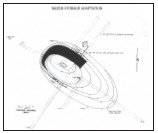 |
 |
 |
 |
 |
 |
 |
 |
 |
 |
 |
 |
 |
| |
 |
 |
 |
|
 |
| |
 |
|
 |
 |
In the late 1990s, Professor James A. Neely published on his excavations at Lefhand Canyon a unique new system of gates and pools that was clearly an agricultural enhancement. This site is located on the northern flanks of the Pinaleno Mountains just south of the Gila River near Safford, Arizona. He has investigated a unique irrigation and garden system. He believes that this site dates to C.E. 1275-1315,and that these were migrant Western Anasazi, based on the pottery styles.
His schematic drawing illustrates small turnouts, or gates, in the canal that controlled amounts of water to be diverted into fields and into stone-bordered “pools.” .... The pools vary in shape and size. In all, about 100 of these pools were recorded in Canal System 1. They were likely designed to impound small amounts of water, where farmers could dip water onto wilting plans, as needed, but their precise function is not known with certainty. He did not know the purpose of the intake gate and pool system.
This was my third specific archaeological find that supports my argument and is now one of six or more specific examples of my proposed use (Neely & Homburg) (below).
Courtesy Professor James A. Neely |
 |
|
|
|
 |
|
|
 |
 |
Small court at Snaketown
The use of Hohokom fertilizer dehydration basins (ballcourt) was contemporary with the Chacoan era C.E. 800-1150. Although designs varied, architectural constructions and methods of producing fertilizer was an integral part of Anasazi, Hohokam, and Paquimé culture during this entire era regardless of geographical location (above). |
 |
 |
 |
 |
 |
 |
 |
 |
 |
|
|
 |
 |
 |
 |
All kivas are not created equal. This Casa Rinconada “kiva” was clearly not a ceremonial chamber. Its designs indicate it could be a fertilizer creation chamber or perhaps even a storage unit. Clearly it does not fit the profile of a religious chamber (above).
Courtesy Kate Baue |
|
 |
Hot Wells Storage Basin with test trenches (Vernon L. Scarborough, 1988) (above).
I propose this is an example of a Jornada Mogollon C.E. 1150-1340 fertilizer dehydration basin. |
|
The Mesa Verde intake system virtually matches the Paquimé system which was perhaps 200 years later and more than 1,000 miles to the south.
This intake basin is probably used to automatically mix and inoculate the incoming water with cynobacteria and/or waste material such as manure to produce a mixture of nitrogen rich water with which high volume, high sugar content crops were hand watered or the sludge could be dehydrated, stored, or transported as needed (above). |
 |
|
 |
|







